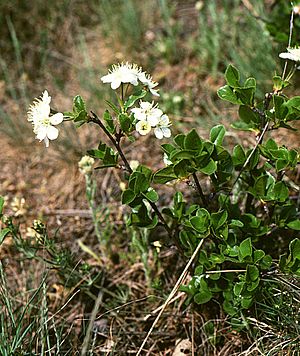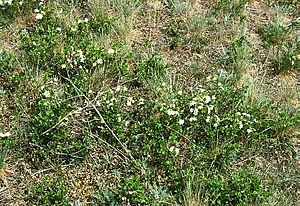European dwarf cherry facts for kids
Quick facts for kids European dwarf cherry |
|
|---|---|
 |
|
| P. fruticosa flowers | |
| Conservation status | |
| Scientific classification | |
| Synonyms | |
|
The European dwarf cherry, also known as dwarf cherry, Mongolian cherry, or steppe cherry, is a special kind of shrub. Its scientific name is Prunus fruticosa. This plant loses its leaves in winter (it's deciduous). It can also live in dry places (it's xerophytic) and is very tough in cold weather. It grows delicious cherries!
You might also hear it called "ground cherry" or "European ground cherry." But be careful! There's another plant called "Groundcherry" that belongs to a different group called Physalis. They are not the same.
The European dwarf cherry grows naturally in many parts of the world. You can find it in places like western Siberia, Kazakhstan, Xinjiang in China, and many countries in Europe. These include western Russia, Ukraine, Poland, Germany, Hungary, and Italy.
Contents
About the European Dwarf Cherry
This cherry plant usually grows as a shrub. It can reach about 1 to 2 meters (3 to 6 feet) tall and just as wide. It can grow in almost any kind of soil, but it likes loam (a mix of sand, silt, and clay) best. The plant spreads by sending out new shoots from its base, called suckers. It has many roots.
The European dwarf cherry needs lots of sunshine. It grows best in open areas like steppes (grassy plains) rather than deep forests. However, it can form thick groups of plants at the edges of open forests.
Leaves and Flowers
The bark of the dwarf cherry is dark brown. It has small yellow spots called lenticels, which help the plant breathe. Its leaves are shaped like a spoon or an upside-down egg. They are about 12 mm long and 6 mm wide. The tip of the leaf comes to a point (this is called an acuminate apex). The top of the leaves is smooth (it's glabrous), thick, and dark green. The edges of the leaves have small, rounded teeth (they are crenate). In autumn, the leaves turn yellow. Each leaf has a short stem called a petiole.
The flowers are white. Each flower has both male and female parts (it's hermaphroditic). They grow in groups of 2 to 4 on short stems called peduncles. These groups of flowers are called umbels. Bees help pollinate the flowers. In places like Europe, the plant usually flowers in May.
Fruit
The fruit of the European dwarf cherry is light to dark red. It can be round or pear-shaped. Each cherry is about 8 to 25 mm (0.3 to 1 inch) wide. The cherries ripen in August. They taste sour-sweet, or tart.
What the European Dwarf Cherry is Used For
Since the cherries have a sour taste, people often use them in cooking. They are great for making jams and jellys. The plant also has some traditional uses in medicine because it can help tighten body tissues (it's an astringent). The flowers are also very good for bees, so beekeepers like this plant for making honey.
Growing and Planting
Prunus fruticosa is often planted in hedgerows. These are rows of shrubs that act like a fence. People use them as an ornamental plant (for beauty), to create privacy, or to block the wind (as a windbreak). The plant also provides a home and food for bees, other helpful insects, and birds.
The roots of this shrub spread out and go deep into the ground. This makes them very useful for keeping soil from washing away. This is important in gardening projects and when trying to bring natural areas back to health (called habitat restoration).
The European dwarf cherry is very tough and can survive harsh conditions. This makes it a good choice for grafting. Grafting is when you join parts of two plants together to grow as one. For example, it can be joined to the root system of a Prunus avium (sweet cherry) tree. This creates a new tree with a rounded top.
How it Was Named and Classified
Linnaeus's Idea
A famous scientist named Carl Linnaeus first wrote about this plant in his book Species Plantarum. He called it Prunus cerasus pumila. The word pumila means "dwarf" in Latin. He thought it was a type of Prunus cerasus, which is the sour cherry.
Pallas's Definition
Later, in the 1700s, a German scientist named Peter Simon Pallas gave the plant its current official name, Prunus fruticosa. He was invited by Catherine the Great to study plants in Russia. Pallas found this shrub growing in the plains of Siberia. He decided it was a separate species, not just a type of sour cherry. He noticed its unique fruit and seeds, which made him classify it as Prunus fruticosa. The word fruticosa means "bushy" or "shrub-like."
Woronow's Attempt
In 1925, another botanist named Yury Nikolaevich Voronov tried to change its name again to Cerasus fruticosa. However, this name was not widely accepted.
Mixing with Other Cherries
The European dwarf cherry is a special plant because it has 32 chromosomes. Scientists believe it is one of the parent plants of the sour cherry (Prunus cerasus). This happened a long time ago when the dwarf cherry mixed with the wild/sweet cherry (Prunus avium) in places where they both grew. All three of these cherry types can mix with each other.
The sour cherry (Prunus cerasus) is now its own stable species, even though it started as a mix of other cherries.
Changes in Nature
Recently, scientists studying wild European dwarf cherry plants in northern Poland found something interesting. The dwarf cherry plants there are slowly disappearing. This is happening because they are mixing naturally with other cherry plants, like the sour cherry and the sweet cherry. When they mix, they create new hybrid plants. For example, mixing with sour cherry creates Prunus × eminens, and mixing with sweet cherry creates Prunus × stacei.
This mixing happens more often now because of how forests are managed. Also, people have planted many sour cherry trees, which produce a lot of pollen. This brings the different cherry types closer together, leading to more mixing and changes in the natural dwarf cherry plants.
See also
 In Spanish: Prunus fruticosa para niños
In Spanish: Prunus fruticosa para niños



